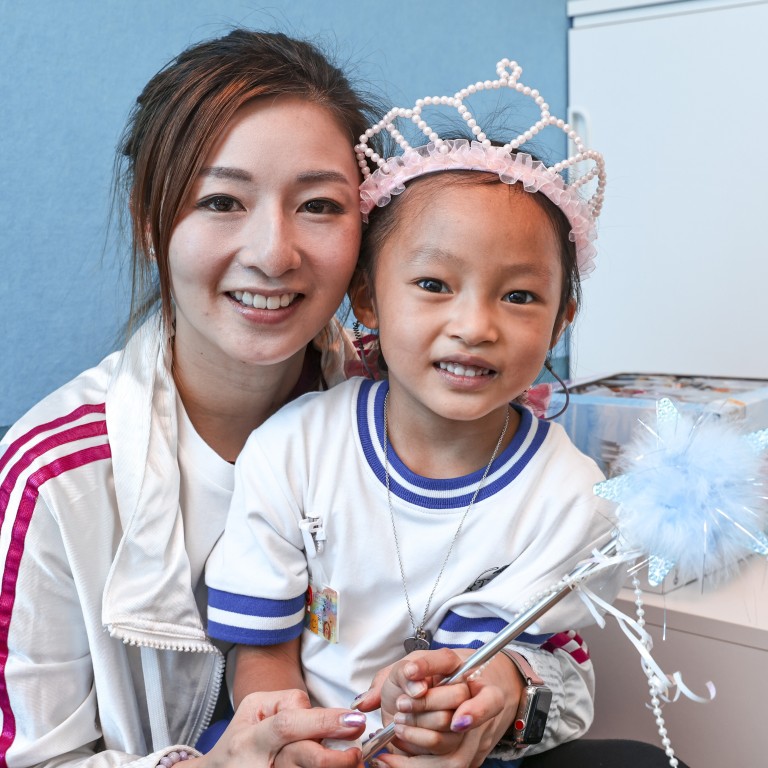
Sign bilingualism: Hong Kong charity aims to boost education for children with hearing disabilities through sign, spoken language combination
- SLCO Community Resources provides sign bilingualism – both signed and spoken language – in education for children with hearing disabilities
- Independent charity hopes to promote sign bilingualism with funding from Operation Santa Claus
Before children learn to speak, it may be challenging for most parents to figure out their little ones’ needs. But for Miyuki Pang, failing to understand her daughter brought extra pain.
“Before she was two years old, my daughter always got frustrated and lost her temper in public when I could not understand what she needed, such as going to the washroom or drinking water,” Pang said.
Her daughter Rihanna, now four, suffers from profound hearing loss, which means she cannot detect any sound lower than 90 decibels – equivalent to riding on a subway – in both ears.
“It is painful when you want to express something but fail to get it through,” Pang said.
But Rihanna is now studying in an integrated class at a mainstream kindergarten after learning some basic sign language two years ago by joining the SLCO Community Resources’ project, which provides sign bilingualism – both signed and spoken language – in education for children with hearing disabilities.

“There are two teachers – one teaching in oral language and the other in sign language – in the class,” Pang said. “Such an approach is truly helpful as I see Rihanna’s progress every day. She can now even understand complicated concepts such as odd and even numbers.”
In Hong Kong, about 1,000 children at primary or secondary school level suffer from hearing loss. About 300 of those are severe cases, according to Education Bureau figures.
But SLCO founder Chris Yiu Kun-man estimated that the actual number of students with hearing problems could be as high as 20,000 if mild cases were counted.
Hong Kong’s waste pickers ‘deserve more respect, better conditions’
He said more than 80 per cent of the 100 hearing-impaired children joining its annual bilingualism project had severe to profound hearing loss. Some have extremely severe loss because of malformed structures in their hearing systems.
But Yiu noted many parents were reluctant to enrol their young ones into sign education, fearing the children would prefer that form of communication over talking.
“They may think that learning sign language may impede spoken language development, but actually it is not the case. Theoretically, they are actually complementing rather than competing with each other,” he said.

He added that sign language had long been sidelined in education for children with hearing disabilities in Hong Kong, as traditionally only verbal communication was used with an emphasis on hearing and speech.
But he said verbal communication barely worked for children such as Rihanna who had severe hearing problems. Yiu said they could miss out on a lot of information trying to lip-read teachers.
“The result is that, many deaf children cannot develop cognitively, socially, or academically,” Yiu said.
One major edge of sign language over speech was that it was a barrier-free medium since users had no problems with vision, he said.
Hong Kong’s PathFinders offering domestic helper mums Brighter Futures
With funding from Operation Santa Claus, Yiu said SLCO hoped to promote sign bilingualism.
“We are happy to be funded by Morgan Stanley [an OSC donor] to run the project this year,” Yiu said. “We also hope to promote sign bilingualism to more mainstream schools and schools for children with other special needs in the years to come.”
He said such an integrated setting also helped children with hearing disabilities to be incorporated into the mainstream community at an early age, while reducing misconceptions towards them.
Yiu also noted that sign language could be beneficial to a wider social spectrum, ranging from children with autism and those experiencing oral delay, to the elderly suffering from hearing loss.

